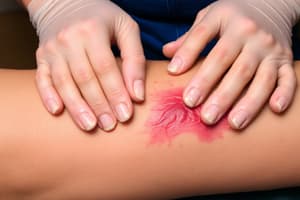Podcast
Questions and Answers
What is the primary intention of wound healing?
What is the primary intention of wound healing?
- Healing involving the closure of a wound with skin or tissue grafts.
- Healing that occurs with significant tissue loss.
- Healing that requires extensive surgical intervention.
- Healing that takes place under clean conditions with minimal scarring. (correct)
Which factor does NOT typically delay wound healing?
Which factor does NOT typically delay wound healing?
- Infection at the wound site.
- Excessive moisture around the wound.
- Poor nutrition.
- Adequate oxygenation. (correct)
Which of the following is a key element in the Braden Scale for assessing pressure injury risk?
Which of the following is a key element in the Braden Scale for assessing pressure injury risk?
- Aging of tissue.
- Mobility level. (correct)
- Color of the wound.
- Size of the wound.
What is the primary purpose of using negative-pressure wound therapy?
What is the primary purpose of using negative-pressure wound therapy?
What is a consequence of tissue necrosis in pressure injuries?
What is a consequence of tissue necrosis in pressure injuries?
Which positioning strategy is recommended to prevent pressure ulcers?
Which positioning strategy is recommended to prevent pressure ulcers?
What role does caloric intake play in wound healing?
What role does caloric intake play in wound healing?
Which nutrition component is essential for optimal wound healing?
Which nutrition component is essential for optimal wound healing?
Pressure ulcers are staged based on which criterion?
Pressure ulcers are staged based on which criterion?
Which of the following describes surgical debridement?
Which of the following describes surgical debridement?
How can psychological implications affect wound care?
How can psychological implications affect wound care?
What psychological impact can wounds have on patients?
What psychological impact can wounds have on patients?
Which debridement method involves using a sharp instrument to remove dead tissue?
Which debridement method involves using a sharp instrument to remove dead tissue?
What does the term 'secondary intention' refer to in wound healing?
What does the term 'secondary intention' refer to in wound healing?
Which wound assessment technique is used to identify organisms for effective antibiotic treatment?
Which wound assessment technique is used to identify organisms for effective antibiotic treatment?
What is the significance of daily weight monitoring in wound care?
What is the significance of daily weight monitoring in wound care?
What appearance is characteristic of slough?
What appearance is characteristic of slough?
Which stage of pressure ulcer includes partial-thickness loss of dermis?
Which stage of pressure ulcer includes partial-thickness loss of dermis?
Which of the following conditions indicates that a patient may be at high risk for skin breakdown according to the Braden Scale?
Which of the following conditions indicates that a patient may be at high risk for skin breakdown according to the Braden Scale?
What is the primary goal of debridement in wound management?
What is the primary goal of debridement in wound management?
What clinical manifestation is a sign of wound infection?
What clinical manifestation is a sign of wound infection?
During a skin temperature assessment, what might a practitioner expect to feel in an ulceration initially?
During a skin temperature assessment, what might a practitioner expect to feel in an ulceration initially?
How can tissue injury in patients be identified?
How can tissue injury in patients be identified?
Which of the following is NOT a potential outcome of untreated ulcers?
Which of the following is NOT a potential outcome of untreated ulcers?
Flashcards
Impaired Skin Integrity
Impaired Skin Integrity
A nursing problem affecting skin, potentially leading to wounds or sores. It can result from various factors like pressure ulcers, immobility, or infections.
Pressure Ulcer
Pressure Ulcer
A localized injury to the skin and underlying tissue, usually caused by prolonged pressure on a confined area of skin.
Osteomyelitis
Osteomyelitis
An infection of the bone, often from bacteria entering through the bloodstream or a nearby infected area.
Nutritional Deficiencies
Nutritional Deficiencies
Signup and view all the flashcards
Wound Care
Wound Care
Signup and view all the flashcards
Pressure Relief
Pressure Relief
Signup and view all the flashcards
Debridement
Debridement
Signup and view all the flashcards
Secondary Intention
Secondary Intention
Signup and view all the flashcards
Pressure Injury Definition
Pressure Injury Definition
Signup and view all the flashcards
Pressure Injury Etiology
Pressure Injury Etiology
Signup and view all the flashcards
Tissue Tolerance Factors in Pressure Injury
Tissue Tolerance Factors in Pressure Injury
Signup and view all the flashcards
Pressure Injury Prevention Measures
Pressure Injury Prevention Measures
Signup and view all the flashcards
Braden Scale Purpose
Braden Scale Purpose
Signup and view all the flashcards
Wound Healing by Intentions
Wound Healing by Intentions
Signup and view all the flashcards
Shearing Force in Pressure Injuries
Shearing Force in Pressure Injuries
Signup and view all the flashcards
Pressure Injury Staging
Pressure Injury Staging
Signup and view all the flashcards
Slough
Slough
Signup and view all the flashcards
Eschar
Eschar
Signup and view all the flashcards
Stage 1 Pressure Ulcer
Stage 1 Pressure Ulcer
Signup and view all the flashcards
Stage 2 Pressure Ulcer
Stage 2 Pressure Ulcer
Signup and view all the flashcards
Stage 3 Pressure Ulcer
Stage 3 Pressure Ulcer
Signup and view all the flashcards
Stage 4 Pressure Ulcer
Stage 4 Pressure Ulcer
Signup and view all the flashcards
Unstageable Pressure Ulcer
Unstageable Pressure Ulcer
Signup and view all the flashcards
Braden Scale
Braden Scale
Signup and view all the flashcards
Study Notes
Wound Healing
- Differentiate among healing by primary, secondary, and tertiary intention.
- Describe wound healing principles.
Nursing Process
- Explain the nursing process in caring for individuals experiencing a wound.
- Describe factors that delay healing or result in complications.
Pressure Injury Etiology
- Explain the etiology and clinical manifestations of pressure injury.
- Discuss using the Braden Scale to assess for pressure injury risk.
Pressure Injury Prevention
- Identify measures used to prevent pressure injury development.
- Explain the nursing and collaborative management of pressure injury with or without infections of the integument.
Pressure Injury Definition
- A localized injury to the skin and/or underlying tissue due to pressure.
Tissue Necrosis
- Cause tissue necrosis, usually over bony prominence.
Oxygenation in Pressure Injury
- If tissue is under pressure against the bone, are the cells receiving oxygen?
Duration of Pressure
- Length of time pressure is exerted (duration).
Tissue Tolerance Factors
- Ability of tissue to tolerate externally applied pressure, influenced by age, density, collagen, and comorbidities.
Shearing Force
- (Not Further Defined)
Friction
- Pressure exerted on the skin when it adheres or sticks to the bed linen and the skin layers slide in the direction of body movement.
- Two surfaces rubbing against each other (sheet and skin when pulling a patient up in bed).
Moisture
- Excessive diaphoresis, urine, or stool.
Pressure Ulcer Staging
- Pressure Ulcers are graded and staged according to the deepest area of tissue damage, from Stage 1 (minor) to Stage 4 (severe).
Slough
- Appearance: Stringy, yellow texture; dead tissue, a vascular.
Eschar
- Black/brown necrotic tissue; a vascular; biologic cover.
Stage 1 Pressure Ulcer
- Intact skin with non-blanchable redness; possible indicators include skin temperature, tissue consistency, pain.
Stage 2 Pressure Ulcer
- Partial-thickness loss of dermis; shallow open ulcer with red/pink wound bed; presents as an intact or ruptured serum-filled blister.
Stage 3 Pressure Ulcer
- Full-thickness skin loss involving damage or necrosis of subcutaneous tissue that may extend down to, but not through, underlying fascia; the wound color includes yellow.
Stage 4 Pressure Ulcer
- Full-thickness loss can extend to muscle, bone, or supporting structures; bone, tendon, or muscle may be visible or palpable.
Unstageable Pressure Ulcer
- Full thickness tissue loss in which the base of the ulcer is covered by slough and/or eschar; the depth and stage cannot be determined until the slough and eschar are removed.
Clinical Manifestations of Wound Infection
- Signs/symptoms include leukocytosis, fever, increased ulcer size, odor, or drainage, necrotic tissue, and pain.
- Untreated ulcers may lead to cellulitis, chronic infection, sepsis, and possibly death.
Braden Scale Total Score
- Total Score of 23 possible; 18 or less indicates High Risk for skin breakdown.
Tissue Injury
- Look for areas of skin darker than surrounding skin; may appear with red, blue, or purple hues in darker skin tones.
Skin Temperature Assessment
- Assess skin temperature using your hand; an ulceration may feel warm initially, then become cooler.
Nursing Problem
- Impaired Skin Integrity related to skin breakdown secondary to pressure ulcer, as evidenced by pressure sore on the sacrum.
Risk for Impaired Skin Integrity
- Risk for impaired skin integrity related to immobility as evidenced by prolonged sitting.
Impaired Skin Integrity
- Skin infection evidenced by open sore.
Osteomyelitis
- Bone infection from bloodstream or nearby tissue.
Nutritional Deficiencies
- Lack of nutrients impairs tissue healing.
Corticosteroid Drugs
- Inhibit inflammatory response, impair healing.
Diabetes Mellitus
- Elevated blood glucose increases infection risk.
Anemia
- Reduced oxygen delivery to cells and tissues.
Wound Care
- Prevent infection and promote healing.
Pressure Relief
- Reduce pressure on vulnerable skin areas.
Debridement
- Removal of necrotic tissue from wounds.
Primary Intention Wound Healing
- Wound healing with neatly approximated edges.
Secondary Intention
- Healing with extensive tissue loss and exudate.
Tertiary Intention
- Delayed suturing after infection resolution.
Complications of Healing
- Issues like dehiscence and hypertrophic scars.
Wound Measurements
- Measured in centimeters: length, width, depth.
Negative-Pressure Wound Therapy
- Suction removes drainage, speeds healing.
Culture and Sensitivity
- Identifies organisms for effective antibiotic treatment.
Levine's Technique
- Method for obtaining wound culture samples.
Psychological Implications
- Concerns about scars and odor during care.
Caloric Intake
- Increased calories and protein for healing.
Enteral Feedings
- Nutritional support via feeding tubes.
Surgical Debridement
- Surgical removal of necrotic tissue.
Moist Wound Healing
- Keeps ulcer bed moist for better healing.
Skin Care Prevention
- Avoid moisture and pressure on skin.
Positioning Devices
- Use pillows and protectors to relieve pressure.
Daily Weight Monitoring
- Track weight to assess nutritional status.
Healing Process
- Includes regeneration and repair of tissues.
Healing Stages
- Initial, granulation, maturation phases of healing.
Exudate Management
- Control drainage to promote healing.
Studying That Suits You
Use AI to generate personalized quizzes and flashcards to suit your learning preferences.





